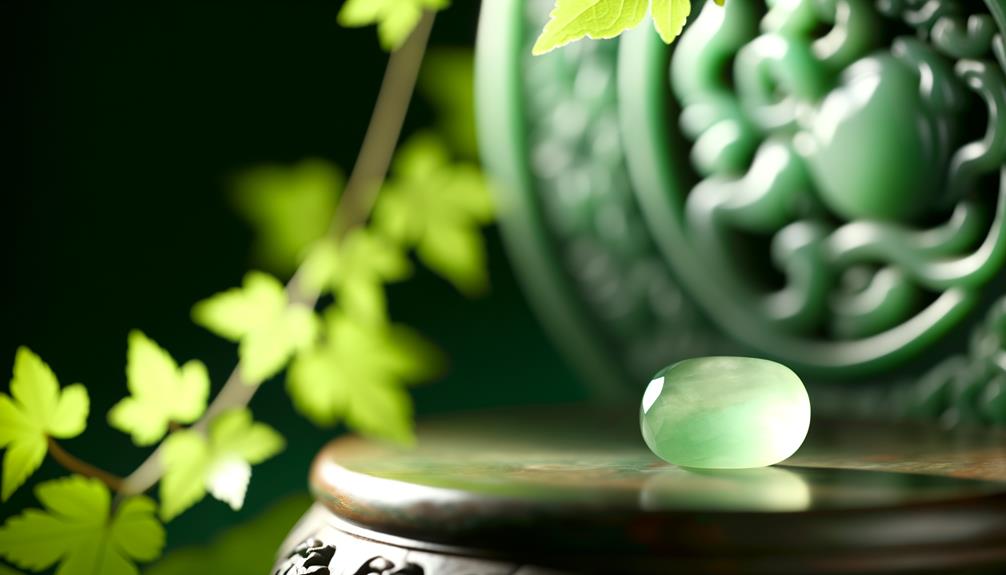Jade Name Meaning and Origin
The name Jade is derived from the precious green gemstone renowned for its aesthetic beauty and spiritual significance. This gemstone has historical roots dating back to the Neolithic period and has been deeply valued in Chinese, Mesoamerican, and Maori cultures.
In China, jade symbolizes purity and moral integrity, while Mesoamerican civilizations associated it with fertility and eternal life. The name Jade embodies attributes of tranquility, emotional balance, and protection.
Today, the gemstone's enduring appeal continues in luxury jewelry and holistic wellness practices. Exploring further reveals more about Jade's multifaceted cultural resonance and enduring legacy.

Key Takeaways
- The name "Jade" is derived from the gemstone revered for its beauty and spiritual significance.
- Jade symbolizes purity, wisdom, and tranquility, reflecting its cultural importance in various ancient civilizations.
- The origin of the name can be traced to the Spanish term "piedra de ijada," meaning "stone of the flank."
- The name gained popularity in English-speaking countries during the 20th century.
- Jade is commonly used for girls' names, symbolizing preciousness and grace.
Historical Origins of Jade
The historical origins of jade trace back to ancient civilizations where it was highly valued for its aesthetic beauty and ritual significance. Archaeological evidence suggests that jade was utilized as early as the Neolithic period, around 6000 BCE.
In China, jade was revered and often crafted into intricate ceremonial objects, tools, and ornaments. Similarly, the Mesoamerican cultures, including the Olmecs and Mayans, utilized jade for creating deities' effigies and burial offerings.
Jade's physical properties, such as its toughness and ability to be finely polished, made it ideal for both practical and decorative uses. This dual function underscores its enduring popularity across different cultures and time periods, marking it as a material of both utility and profound symbolism.
Cultural Significance
Jade's intrinsic value extends beyond its physical attributes, deeply embedding itself within the cultural and spiritual fabric of numerous societies.
In Chinese culture, jade is revered as the 'Stone of Heaven,' symbolizing purity and moral integrity.
It has also played an essential role in Mesoamerican civilizations, such as the Mayans and Aztecs, where it was utilized in religious rituals and as a marker of social status.
Similarly, in Maori culture, jade, known as 'pounamu,' is considered a taonga (treasure) and is used in creating traditional weapons and jewelry, passed down through generations.
These diverse cultural contexts underscore jade's multifaceted significance, transcending mere aesthetics to embody deeper societal values and traditions.
Meaning and Symbolism
Often regarded as a symbol of purity and tranquility, jade has been imbued with profound meaning and symbolism across various cultures throughout history.
In ancient China, jade was revered as a stone of heaven, embodying the virtues of wisdom, justice, compassion, and modesty.
The Mesoamerican civilizations, such as the Maya and Aztec, esteemed jade as a stone of fertility and eternal life, often incorporating it into regal and religious artifacts.
Moreover, in metaphysical traditions, jade is believed to promote emotional balance, protection, and harmony.
Its enduring significance is reflected in its persistent use in ceremonies, amulets, and art, signifying not just beauty, but a deeper spiritual resonance and an embodiment of cultural values.
Jade in Modern Times
How has jade maintained its cultural and aesthetic significance in modern times despite the advent of new materials and changing fashions?
Jade continues to be revered for its historical and spiritual connotations. Its enduring appeal lies in its unique properties, such as its rich green color and luster, which modern synthetics often fail to replicate.
Additionally, jade's symbolism, encompassing virtues like harmony, balance, and protection, resonates deeply across cultures, particularly in East Asia.
Contemporary designers incorporate jade into high fashion, jewelry, and home décor, bridging traditional craftsmanship with modern aesthetics.
Furthermore, jade's significance in holistic wellness practices, including feng shui and crystal healing, underscores its timeless relevance.
Hence, jade's multifaceted allure guarantees its continued prominence in contemporary society.
Popularity and Trends
In contemporary markets, the popularity of jade is evident in its widespread use across various sectors, from luxury jewelry to wellness practices, reflecting its enduring appeal and adaptability to modern trends. Jade's resurgence can be attributed to its historical significance and versatile applications.
- Luxury Jewelry: High-end brands frequently incorporate jade into their collections, highlighting its premium status.
- Wellness Practices: Jade rollers and gua sha tools are popular in skincare routines for their purported health benefits.
- Fashion Accessories: Designers employ jade in accessories, adding a touch of elegance and cultural heritage.
- Collectibles and Investments: Jade artifacts and sculptures are sought after by collectors, serving both as art and valuable investments.
These trends underscore jade's multifaceted relevance in contemporary society.
Conclusion
To sum up, the name Jade, with its historical origins and multifaceted cultural significance, has transcended time to become a symbol of both material and spiritual wealth.
The rich tapestry of meanings and symbolism attached to Jade, coupled with its modern-day popularity, illustrates society's unyielding penchant for attributing profound qualities to mere nomenclature.
Evidently, the allure of Jade endures, proving that humanity's fascination with names may be as eternal as the stone itself.






